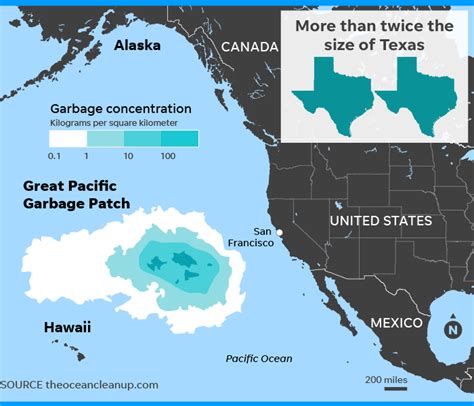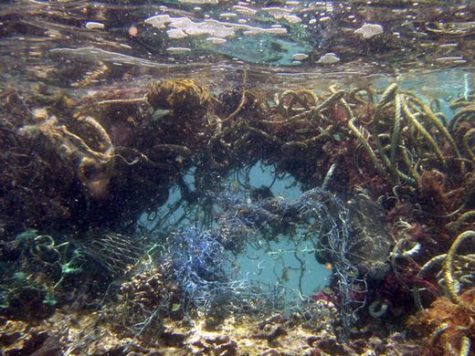Earth Day every day
On April 22 the United States celebrates Earth Day. For 3.5 billion years this planet has sustained life. The beauty of the earth is its ability to sustain life. It is the only place currently known with this capability; yet, a lot of the time, humans treat it as if it is a hotel room that a housekeeper will clean up when people move to Mars. Right now there is an extensive debate on whether climate change is real and if it is human-caused. However, there is one environmental issue no one denies: there is plastic in the oceans, and it is not going away.

Map of The Great Pacific Garbage Patch, now twice the size of Texas
Plastic was a life-changing material. It can arguably be considered one of the greatest inventions since the wheel, but it can also be considered one of the most deadly. When plastic is used correctly, it is incredible. For the environment single-use plastics, tend to do more damage than good. According to Earth Day, “Landfills and the natural environment hold 79% (5.5 billion tons) of all the plastic ever produced, with 40% of plastic only being used once.” Even if the plastic is recycled, there is a greater chance will probably not be reused. Plastics are convenient and durable, which is what makes them so harmful. It’s important to look at if the use of it for a couple of minutes worth the 500 to an infinite amount of years it will stay in the in landfills.

Photo of The Great Pacific Garbage Patch appearing on National Geographic
Microplastics and marine life
Microplastics are any piece of plastic under five millimeters long. In 2015, the US banned microbeads, which were any plastic manufactured to be that small, but that did not stop the issue. All plastics eventually break down into microplastics, and in a recent study, Professor Richard Thomas found that plastic is not broken down by waves and sunlight alone. National Geographic said, “They’d watched amphipods of the species Orchestia gammarellus—tiny shrimplike crustaceans that are common in European coastal waters—devour pieces of plastic bags and determined they could shred a single bag into 1.75 million microscopic fragments. The little creatures chewed through plastic especially fast, Thompson’s team found, when it was coated with the microbial slime that is their normal food. They spat out or eventually excreted the plastic bits.”
Plastic is to blame for millions of marine life deaths every year. Washed up whales have been found with over 40 pounds of plastic in their bellies. Toxic chemicals and pesticides cling to the microplastics that are then consumed by zooplankton and coral along with 700 other species. The Ocean Cleanup Foundation said, “Research indicates that half of sea turtles worldwide have ingested plastic. Some starve after doing so, mistakenly believing they have eaten enough because their stomachs are full. On many beaches, plastic pollution is so pervasive that it’s affecting turtles’ reproduction rates by altering the temperatures of the sand where incubation occurs.”
The response around the world
Around the globe, communities are taking the pledge to go zero-waste, meaning instead of just burning their waste, they recycle it. By doing so, they have experienced drastically cleaner air and more jobs. Some cities in the United States have pledged to send “zero-waste to landfills,” but that means that there still is some waste being incinerated and adding to air pollution. The Environmental Protection Agency (EPA) estimates that 75 percent of the United States’ waste stream can be recycled or composted, but only over 34 percent actually is. Since China has stopped accepting other countries trash this issue is now each for their own. According to the Korea Herald, “Residents of South Korea have to pay for trash by weight, causing an 83% increase in recycling and composting rate.
OHS taking action
Students Matthew Bueltel and Mary Sager participated in the youth climate strike this spring and Rochester schools put together a rally where students can sign petitions to initiate environmental policies getting turned into law. Mary Sager said, “It was super inspiring to see all of these young people trying to make a difference. Here at OHS, Mr. Muir is selling earth day t-shirts and encouraging students to examine their ecological footprint. Biology teacher Mr. Muir said, “Earth day is a day to recognize all the ecological services our planet has: food, water, beauty, but sadly, humans are having a massive impact on those services. I try to not focus on the sad things though, we have solved the ozone problem that was big years ago but, we need to start making changes now.”

Lauren Arthur is in a plethora of school activities but she spends most her time doing the hobbies of a grandmother. Those hobbies include quilting, gardening...

